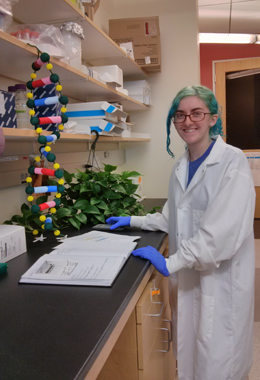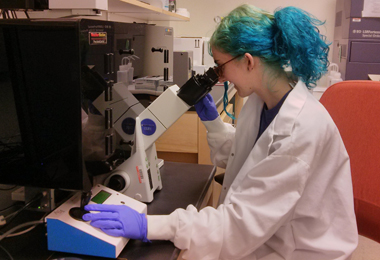TILF Success Stories: Meet Samantha Preisser
Posted by Trudy Richards on 04/02/2014

Samantha Preisser knew about UIL sports and music competitions, but didn’t find out about UIL math and science contests until her AP Biology class senior year.
Matthew Fields, AP Biology teacher at J.J. Pearce high school, said he recruited Samantha to UIL because she was a top performer in classes and “seemed perfect for the team.”
“She always was ready and up to the challenge,” Fields said.
Samantha competed in the UIL science contest, which includes tests in Biology, Chemistry, and Physics. The team, she said, got along well and developed a helpful learning environment.
“We spent a tremendous amount of time preparing,” Fields said, “Our strategy was to continuously perform at our highest level and to ultimately advance to the state competition even though we were in a tough district.”
The team did advance to the state competition and became the first group of students from J.J. Pearce High school to make it to regional and state-level competition for Science UIL.
“I could not have been more proud to be able to push myself beyond what I ever thought was possible,” Samantha said. “Pearce is very competitive in many other UIL events, so it was shocking that we were the first to achieve something like that.”
Now attending the University of Texas at Dallas, Samantha is a Welch Foundation scholar studying Biochemistry.
“Receiving the TILF scholarship has helped me go above and beyond the basic 'Undergraduate Education = Earning a Degree' model,” she said. “It has helped me tremendously in affording my textbooks but also allowed me to fully experience my minor, Spanish and Hispanic Area Studies.”
Because of this financial freedom, Samantha was able to study abroad. In summer 2012, she took classes at the University of Navarra and stayed with a host family in Pamplona, Spain.
“This immersion experience was my first time even leaving the United States and changed my perspective in a huge way,” she said. “They were kind and immensely helpful in acclimating me to both the Spanish culture and language. I had a wonderful experience and now speak Spanish with much more ease than I ever had in my six years of Spanish classes.”
Like many college students, Samantha has a variety of interests and options to pursue. Samantha started working with different facets of bioengineeering research last spring. She participated in the International Genetically Engineered Machine (iGEM), a synthetic biology competition which challenges high school and college students to tackle real-world issues using a bank of ‘biobricks’ to build from.
“iGEM introduced me to real synthetic biology labwork in an easy-to-understand format that pushed me to apply what I had learned it in a meaningful way,” Samantha said. “I spent several months working on my team's cavity prevention project over the summer and fall and we were able to travel to Toronto to compete in the North American regional competition where we managed to earn a silver medal.”
 Currently, she is researching the CRISPR Cas9 gene editing system. The system is a recent discovery, but Samantha says “it’s one of the most precise ways to edit DNA in cells to date.”
Currently, she is researching the CRISPR Cas9 gene editing system. The system is a recent discovery, but Samantha says “it’s one of the most precise ways to edit DNA in cells to date.”
“Now they’re using it to edit DNA in human cells and animal cells,” she said. “There’s a lot of different applications, but it’s huge in cancer research.”
Samantha explains how a bacterial immune system can recognize foreign DNA and how scientists are learning to modify genetic material and ultimately, change the behavior of an organism. In the lab, she is involved with making donor plasmids that are later inserted into cells.
“We damage the DNA in the cell, we cut it, and modified DNA goes in. It’ll repair itself using homologous recombination using modified DNA,” she said. “Hopefully, I’ll change the DNA to whatever I want it to be, so it can fluoresce, exhibit some other resistance or some sort of marker.”
Samantha is excited to see how scientific discoveries can change health for years to come. For her own future, Samantha is keeping her options open, from pursuing medical school to exploring alternative fields in medicine.
“I hold one idea above all else in the process of deciding my career, which is that I want to make a difference in people's lives,” she said. “Whether it be giving them the strength to smile, consoling them in a trying situation, or researching disease therapy, I want to provide hope for a better tomorrow.”
Written by Jan Ross Piedad